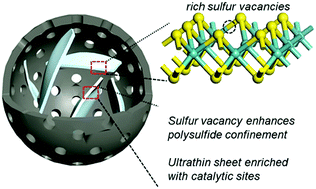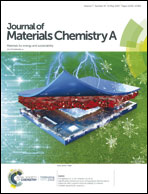Sulfur-deficient MoS2 grown inside hollow mesoporous carbon as a functional polysulfide mediator†
Abstract
Lithium–sulfur (Li–S) batteries are regarded as one of the most promising next-generation electrochemical cells. However, shuttling of lithium polysulfide intermediates and sluggish kinetics in random deposition of lithium sulfide (Li2S) have significantly degraded their capacity, rate and cycling performance. Herein, few-layered MoS2 nanosheets enriched with sulfur vacancies are anchored inside hollow mesoporous carbon (MoS2−x/HMC) via S–C bonding and proposed as a novel functional mediator for Li–S batteries. Ultrathin MoS2 sheets with abundant sulfur vacancies have strong chemical affinity to polysulfides and in the meantime catalyze their fast redox conversion with enhanced reaction kinetics as proved by experimental observations and first-principles density functional theory (DFT) calculations. At a current density of 1C, the MoS2−x/HMC-S composite cathode exhibits a high initial capacity of 945 mA h g−1 with a high retained capacity of 526 mA h g−1 and a coulombic efficiency of nearly 100% after 500 cycles. The present work sheds light on the design of novel functional electrodes for next-generation electrochemical cells based on a simple yet effective vacancy engineering strategy.

- This article is part of the themed collection: 2019 Journal of Materials Chemistry A Most Popular Articles


 Please wait while we load your content...
Please wait while we load your content...